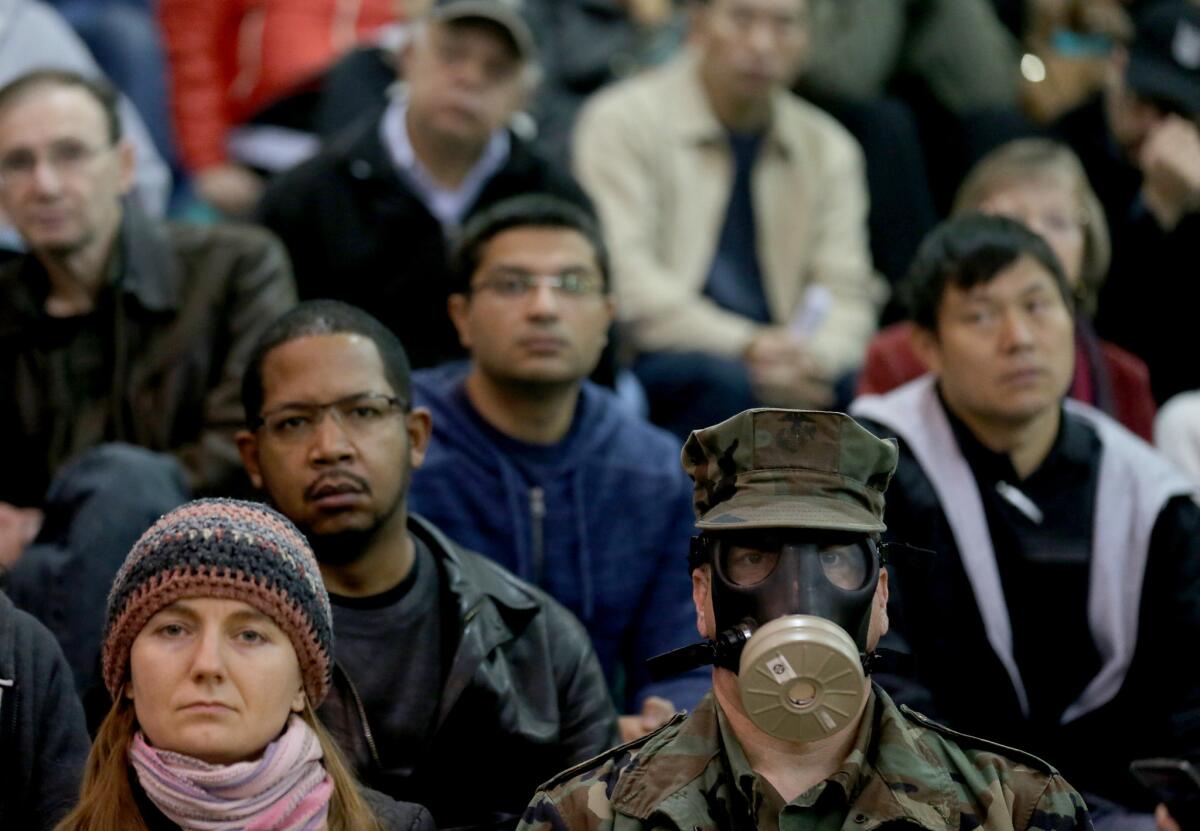Benzene risk from Porter Ranch gas leak is the same as rest of region, study finds

Brian Seligman, a former Marine, wears a gas mask as he joins hundreds of people gathered in the gym of Granada Hills Charter High School to participate in a meeting of the South Coast Air Quality Management District last week.
- Share via
The first study of the health risks posed by emissions of benzene from a massive natural gas leak near Porter Ranch has found that cancer risk from the toxic air pollutant is similar to levels found throughout the Los Angeles Basin.
The preliminary assessment released Friday by the South Coast Air Quality Management District estimates that six months of exposure to benzene from the gas leak poses to Porter Ranch residents an increased cancer risk of up to 2 in a million, a level that is at or below benzene risk throughout the region.
The findings come amid concern in recent weeks over levels of benzene, a known carcinogen, detected over the last three months by air monitoring devices deployed throughout Porter Ranch by Southern California Gas Co.
The utility has taken more than 1,000 air samples, collecting them twice a day at 10 locations in the San Fernando Valley neighborhood since late October, when a failed well at its Aliso Canyon storage field in the Santa Susana Mountains began spewing natural gas into the air.
The cancer risk assessment is based on a smaller number of samples that the air district collected independently throughout the community and one sample taken very close to the wellhead.
The estimated cancer risk of 2 in a million is slight enough that it’s difficult to distinguish from preexisting air pollution health risks, AQMD officials said.
The Porter Ranch area has a cancer risk of between 400 and 500 in a million from all toxic air pollutants, according to the air district. That’s about half of what is found in some of the region’s most polluted communities near the ports of Los Angeles and Long Beach, according to a 2014 study by the air quality agency.
The natural gas coming out of the failed well is mostly methane, a compound that does not pose health risks on its own. But the gas also contains toxic air pollutants, including benzene and toluene.
The state Office of Environmental Health Hazard Assessment has reviewed the air sampling data collected by the gas company and concluded that the levels of benzene and other air toxics detected in the community “are below the level of concern for chronic health effects” and that any increase in cancer risk “is likely very small.”
On average, the benzene detected in Porter Ranch has been at or below levels typically found in the Los Angeles region, air quality regulators said.
“There is benzene in the air all over Southern California and the levels we’re seeing in this community are very similar to those levels,” said Philip Fine, deputy executive officer for the air district.
Typical background concentrations of benzene in the Los Angeles region are between 0.1 and 0.5 parts per billion. But they can spike significantly higher in some communities.
Peak levels of the carcinogen in the air have in recent years exceeded 1.7 parts per billion in Compton and Huntington Park, according to data from the air district’s long-term monitoring sites.
Because the gas company’s company readings of benzene are taken instantaneously, air quality officials said they should be compared only to the state’s short-term health standard of 8 parts per billion, rather than the long-term standard of 1 ppb that is based on exposure over much of a lifetime.
The highest benzene level detected by the gas company in Porter Ranch, on Nov. 10, was 5.55 parts per billion. Another sample collected the same day was 3.68 ppb.
Earlier this week, the gas company acknowledged that it has understated the number of times it has detected elevated levels of benzene in Porter Ranch.
A summary of the utility’s air monitoring data on its website had cited only two samples that were “slightly higher” than 2 parts per billion.
In fact, a third sample detected benzene at 2.77 ppb on Nov. 18.
“It was an oversight,” Kristine Lloyd, a spokeswoman for the gas company said Thursday, adding that the company’s website was being updated with the correct information.
In December, the utility acknowledged its summary of air quality monitoring tests in the community had misstated that levels of hydrogen sulfide were “intermittent, very low” and below state standards.
In fact, an air sample on Nov. 12 detected hydrogen sulfide levels of 183 parts per billion — six times the state’s health standard for short-term exposure to that compound.
The company later revised its website.
Since being detected on Oct. 23, the gas leak has driven thousands from their homes, with many complaining of headaches, nausea and other symptoms.
State and county health officials say those health problems are caused by trace amounts of foul-smelling odorants called mercaptans. The non-toxic chemicals are added to natural gas for leak detection and are not expected to pose long-term health risks.
For more environment and air quality news, follow @tonybarboza on Twitter.
More to Read
Sign up for Essential California
The most important California stories and recommendations in your inbox every morning.
You may occasionally receive promotional content from the Los Angeles Times.











